- Home
- Editorial
- News
- Practice Guidelines
- Anesthesiology Guidelines
- Cancer Guidelines
- Cardiac Sciences Guidelines
- Critical Care Guidelines
- Dentistry Guidelines
- Dermatology Guidelines
- Diabetes and Endo Guidelines
- Diagnostics Guidelines
- ENT Guidelines
- Featured Practice Guidelines
- Gastroenterology Guidelines
- Geriatrics Guidelines
- Medicine Guidelines
- Nephrology Guidelines
- Neurosciences Guidelines
- Obs and Gynae Guidelines
- Ophthalmology Guidelines
- Orthopaedics Guidelines
- Paediatrics Guidelines
- Psychiatry Guidelines
- Pulmonology Guidelines
- Radiology Guidelines
- Surgery Guidelines
- Urology Guidelines
One of largest study links osteoporosis with dementia

A positive association was found between osteoporosis and dementia in patients followed in general practices, reports a study published in the Journal of Alzheimer's Disease. Osteoporosis was associated with a 1.2-fold increase in the risk of being diagnosed with dementia in women and a 1.3-fold increase in the risk of being diagnosed with dementia in men.
Kostev Kare and his associates conducted a study to investigate the impact of osteoporosis on the risk of developing dementia in almost 60,000 patients followed for up to 20 years in more than 1,200 general practices in Germany.
"There is a big interest in the relationship between osteoporosis and dementia," explained lead investigator Prof. Karel Kostev, Dr. MS, from the Epidemiology Team of IQVIA, Frankfurt, Germany. "This study is the first to address this question in a very large database enabling the case-control-comparison between patients with and without osteoporosis."
The researchers conducted a retrospective study which included patients who received an initial diagnosis of osteoporosis and were followed by 1,215 general practitioners in Germany between January 1993 and December 2012 (index date). Controls were matched (1:1) to osteoporosis patients using propensity scores based on age, gender, index year, comorbidities, and co-therapies. Kaplan-Meier curves were performed to study the development of dementia separately in men and women with or without osteoporosis within 20 years of the index date.
The primary outcome of the study was to determine the proportion of patients with all-cause-dementia diagnoses within 20 years of the index date. The study included 29,983 patients with osteoporosis and 29,983 controls without osteoporosis and was followed up for 20 years.
Read Also:How a Mediterranean diet could reduce osteoporosis
Key study findings:
- 20.5% of women with osteoporosis and 16.4% of controls had been diagnosed with dementia.
- At the end of the follow-up period, dementia was found in 22.0% of men previously diagnosed with osteoporosis and 14.9% of men without this chronic condition.
- Osteoporosis was associated with a 1.2-fold increase in the risk of being diagnosed with dementia in women and a 1.3-fold increase in the risk of being diagnosed with dementia in men.
"The major hypothesis to explain the association between osteoporosis and dementia is that these two conditions have similar risk factors noted co-author Louis Jacob, "These factors include APOE4 allele of the apolipoprotein E, a major cholesterol carrier, lower vitamin K levels, vitamin D deficiency, but also androgens and estrogens.".
“The strengths of this work are the number of patients available for analysis, the duration of follow-up, and the use of real-world data pertaining to diagnoses in primary care practices where diagnoses are continuously documented, allowing for unbiased exposure assessment (no recall bias),”write the authors.
Osteoporosis is estimated to affect 200 million women across the world. It is a disease where increased bone weakness increases the risk of a broken bone. It is the most common reason for a broken bone among the elderly.

Disclaimer: This site is primarily intended for healthcare professionals. Any content/information on this website does not replace the advice of medical and/or health professionals and should not be construed as medical/diagnostic advice/endorsement or prescription. Use of this site is subject to our terms of use, privacy policy, advertisement policy. © 2020 Minerva Medical Treatment Pvt Ltd